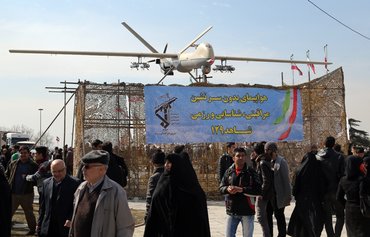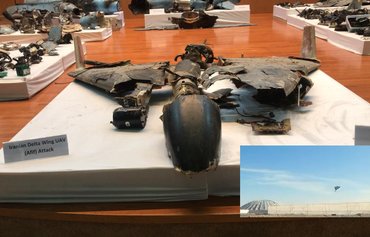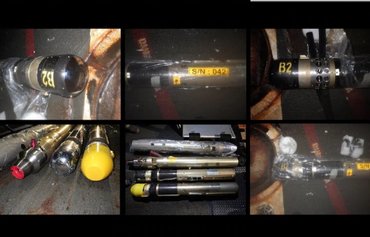Saudi Arabia on Wednesday (September 18th) presented evidence which it said proved the missiles and unmanned aerial vehicles (UAVs), known as drones, that targeted two Aramco oil facilities on Saturday were Iranian.
"The attack was launched from the north and unquestionably sponsored by Iran," defence ministry spokesman Turki al-Maliki said at a press conference held by the ministry in Riyadh. "We are working to know the exact launch point."
He said a combination of 18 UAVs and seven cruise missiles were fired at the Abqaiq and Khurais facilities from a direction that ruled out Yemen as a source.
Photos and remnants of the missiles that targeted the two Aramco facilities were displayed at the press conference.
![The remnants of an Iranian Delta Wing unmanned aerial vehicle that struck a Saudi oil installation are displayed at a Wednesday (September 18th) press conference in Riyadh. [Photo courtesy of Saudi Ministry of Defence]](/cnmi_di/images/2019/09/20/20038-Iran-drone-remains-600_384.jpg)
The remnants of an Iranian Delta Wing unmanned aerial vehicle that struck a Saudi oil installation are displayed at a Wednesday (September 18th) press conference in Riyadh. [Photo courtesy of Saudi Ministry of Defence]
![A fire blazes at the Saudi Aramco facility in Khurais in the aftermath of the Saturday (September 14th) attack. [Screenshot of a YouTube video recorded by a Saudi citizen]](/cnmi_di/images/2019/09/20/20039-Aramco-facility-fire-600_384.jpg)
A fire blazes at the Saudi Aramco facility in Khurais in the aftermath of the Saturday (September 14th) attack. [Screenshot of a YouTube video recorded by a Saudi citizen]

The Balaban missile, one of a new generation of Iranian guided missiles that was revealed last month, is seen here in a photo published by Iran's Fars News Agency.
Iranian-made Delta Wing UAVs took part in the attack, in addition to 'Ya Ali' precision-guided cruise missiles, al-Maliki said.
Meanwhile, Iran continued to deny its involvement and to divert attention to Yemen's Houthis (Ansarallah), a militia backed by its Islamic Revolutionary Guard Corps (IRGC), which had earlier claimed responsibility for the strikes.
"We have evidence of Iranian involvement in acts of sabotage in the region through its proxies," al-Maliki said.
But the kingdom has evidence indicating the oil facility attacks did not originate from Yemen, he said, "as Iran's affiliates have claimed".
"The targeted plant is outside the range of UAVs launched from the areas controlled by the Houthi militia," al-Maliki said.
Late Wednesday, CBS News cited an unnamed US official as saying that Iran's supreme leader Ayatollah Ali Khamenei approved the attack, on condition that it be carried out in a way to deny Iranian involvement.
US officials quoted said the most damning evidence against Iran was unreleased satellite photos showing the IRGC making preparations for the attack at its Ahvaz airbase.
Wreckage yielded 'solid evidence'
"From the first moment of the attack, indubitable suspicions pointed to Iran, despite its attempt to shift culpability to the Houthis," Saudi military expert Mansour al-Shehri told Al-Mashareq.
Conclusive evidence has now been obtained from the wreckage of the missiles found inside the facilities that were hit and others that exploded in the desert away from the installations, he said.
The condition of the remnants was such that it yielded solid information that implicates Iran, he said, pointing out that the technologies and material used in their manufacture were confirmed to be of Iranian origin.
Investigations into the weapons' guidance instruments and calculations related to the course and time of their trajectory are ongoing for the purpose of arriving at full confirmation of culpability, al-Shehri said.
He said it seems the IRGC tried to hide its hand by flying the missiles at low altitude and along a circuitous course.
He also said it seems likely that the missiles were launched from near the Iraq-Iran border, and flew over Kuwaiti airspace to reach the kingdom, entering at a point where Saudi Arabia has fewer anti-missile defence systems.
"Most of the kingdom's air defence systems in this area are directed towards the Yemeni border," he said, noting that coverage is naturally tilted towards the "hot" borders, and it is possible that a resulting gap in coverage has been exploited.
Gulf states raise readiness levels
UN experts left for Saudi Arabia Wednesday to probe the weekend blasts, Secretary-General Antonio Guterres said, as he warned of "devastating" consequences if the crisis escalates.
The UN chief said that the experts were authorized to start a probe under the Security Council resolution that endorsed the 2015 nuclear agreement with Iran.
"This was an Iranian attack," US Secretary of State Mike Pompeo said Wednesday before landing in Jeddah to meet with Saudi Crown Prince Mohammed bin Salman, calling it "an act of war".
"This is an attack of a scale we have just not seen before," he said.
Pompeo, who is on a Gulf tour to discuss Washington's response to the strikes, said Thursday his country wanted a "peaceful resolution" to the crisis.
"We'd like a peaceful resolution. I hope the Islamic Republic of Iran sees it the same way," he told reporters after talks with the leaders of the UAE.
The UAE on Thursday followed Saudi Arabia in joining a US-led force that includes Australia, Britain and Bahrain to protect Gulf shipping and safeguard trade and the flow of oil through the Strait of Hormuz.
"The UAE's accession to the alliance comes in support of regional and international efforts to deter threats to maritime navigation and global trade," the director of its international security co-operation department, Salem Mohammed al-Zaabi, said in a statement.
The UAE joined "in order to secure the flow of energy supplies to the global economy and contribute to maintaining international peace and security", he said.
Kuwait's army said Wednesday it was raising its readiness levels and carrying out military exercises, as it investigated accounts that a drone intruded into its airspace and flew over the royal palace on Saturday.
Kuwait said it was aiming to reach the "highest levels of readiness and combat efficiency" in order to "preserve the security of the country and the safety of its lands, waters and airspace from any potential dangers".

![Remnants of the missiles and drones that targeted Saudi Aramco facilities are displayed at a press conference in Riyadh held by the Saudi Ministry of Defence. [Photo courtesy of Saudi Ministry of Defence]](/cnmi_di/images/2019/09/20/20037-Saudi-missile-remnants-600_384.jpg)







Where’s the evidence? Iranian-made planes?? Doesn’t Saudi Arabia know about the close relations between Iran and Yemen? If the strike had been launched by the Revolutionary Guards, Iran would have certainly known about it. The money that the Saudis paid to harm neighbouring countries is now reaping its fruit.
Reply3 Comment(s)
If Iran wanted to strike, would it fear the humiliated Gulf states?! It has already shot down an American plane over the Gulf. Iran is ready for all threats against its security.
Reply3 Comment(s)
If it were true, where are the AWACS and US-made missile systems in Saudi Arabia? By God, the Gulf states will be the fuel of war that America will ignite in order to put its hands on their money under the pretext of defending them. However, their Wahhabi hatred has blinded them and they no longer differentiate between enemies and friends.
Reply3 Comment(s)